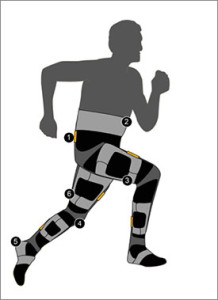When the term “exoskeleton” comes to mind, it’s easy to think about science fiction or bulky military enhancements. The idea of military driven by men with the strength of robots has conjured up dreams for decades. But what if the future of exoskeletons isn’t Iron Man or Master Chief, but grandma maintaining her self-reliance by getting some help with simple acts like walking up the stairs?

The soft exosuit uses a combination of sensors, including a hyper elastic strain sensor (1) and sensors around the wearer’s hip, calf and ankle (2)-(5), all secured by straps. Flexible membranes cover sensors and straps (6)
“Soft” exoskeletons, developed by researchers at the Wyss Institute at Harvard University, certainly have military applications. But these exoskeletons are pants. Comfortable pants. These pants would have a waist belt, two thigh pieces, and two calf straps. Cables are attached through to a motor placed on the wearer’s back in a backpack. The thigh pants monitor the human gait, which the researchers place into “human kinematics,” the study of the motion of multi-joint systems. The sensors use electro-myography, a procedure used to assess the health of muscles and the nerve cells that control them, and to determine the parts of the body that need the most assistance.
Participants in the experiments carried thirty percent of their body weight at three miles per hour on a treadmill, slightly faster than the average human walking speed of two and a half. They would walk normally, walk with the weight, and then walk with the weight and the exosuit. The efforts seemed to put a strain on the body that without the suit would be manageable but still noticeable. The results were also noticeable. Measuring the metabolism and strain of each participant, the researchers determined there was “a significant metabolic power reduction” while wearing the exosuit. The participants’ hips, knees, and ankles were also all working significantly less while the exosuit was on.
This wasn’t the Wyss Institute’s first foray into robotic wearable, they’ve also worked with exo gloves. And while their work has been put into a military milieu, it’s clear that the Institute has an eye towards commercial sales. “A key feature of exosuits is that if the actuated segments are extended the suit length can increase so that the entire suit is slack, at which point wearing an exosuit feels like wearing a pair of pants and does not restrict the wearer whatsoever.”
No comments:
Post a Comment